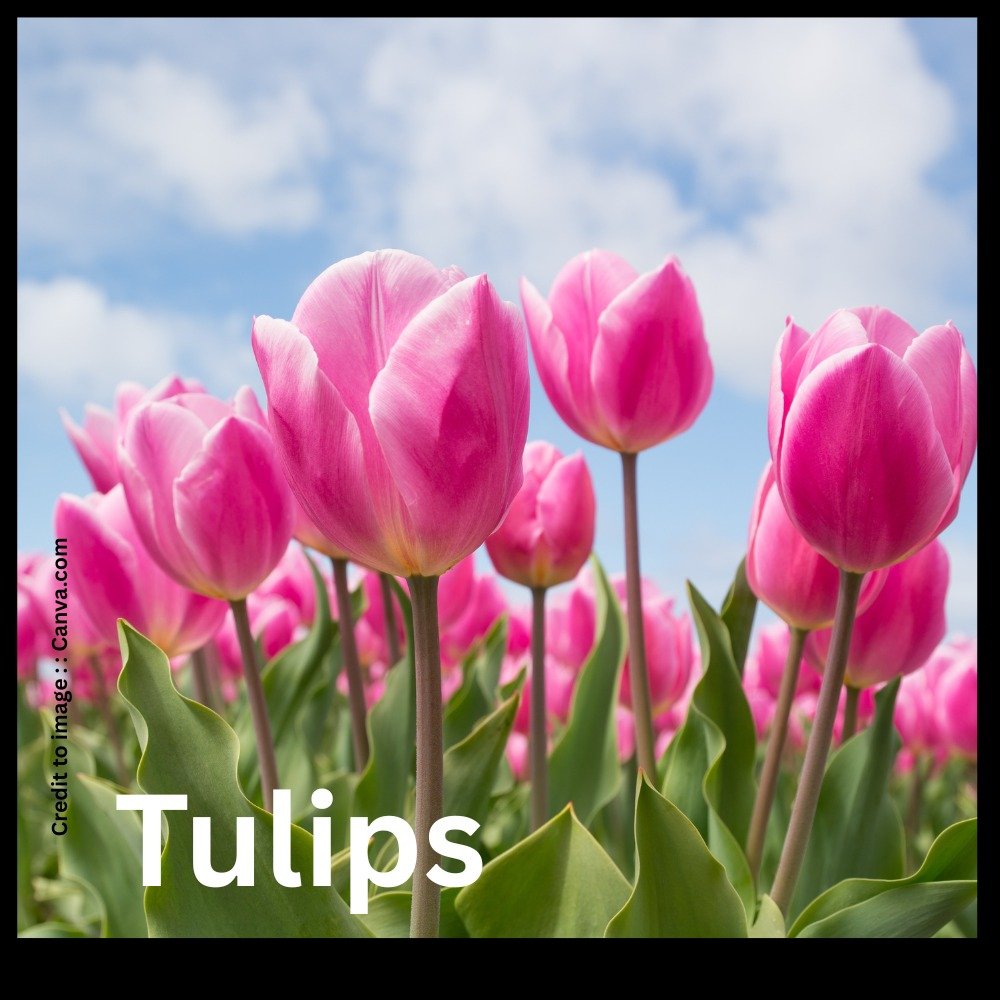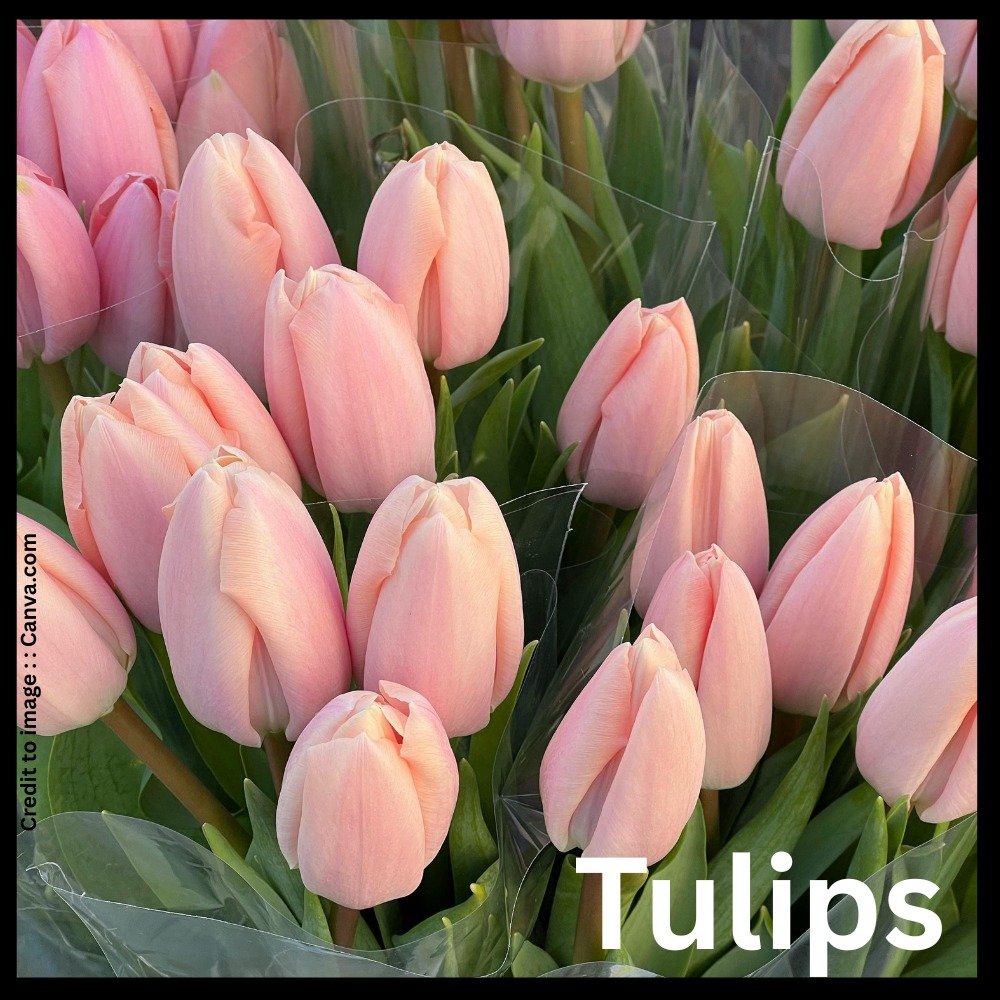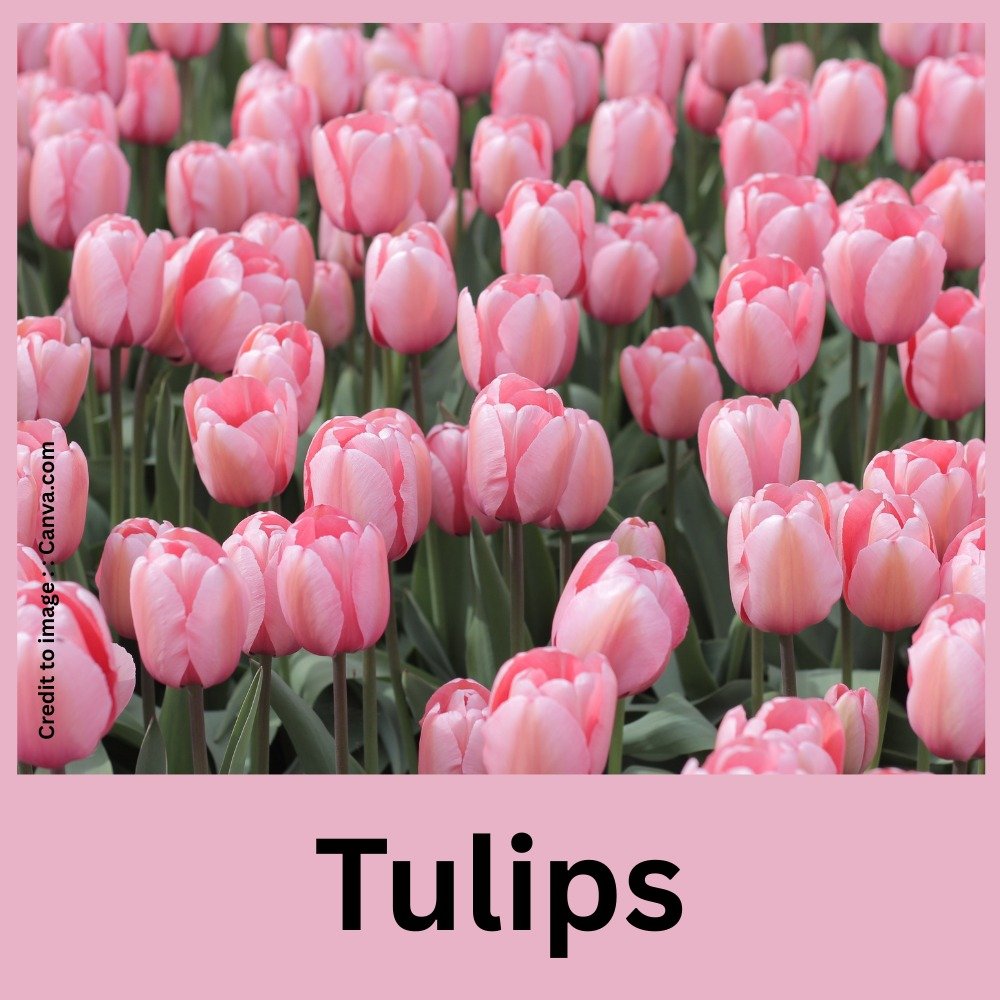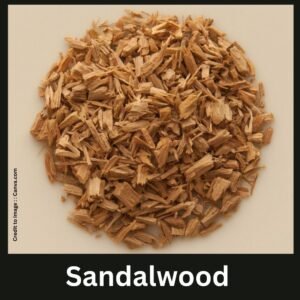Tulips are iconic spring geophytes prized for their clean geometry, dazzling palette, and cultural history from the Ottoman courts to Dutch fields. Article “Tulips “distils scientific traits, geographical requirements, practical uses, and current trade signals into quick-scan tables, followed by a readable guide for gardeners, students, and nature writers.
Introduction to Tulips :
Tulips (genus Tulipa) are perennial flowering plants that grow from bulbs. Belong to the lily family (Liliaceae). Native to Central Asia, they spread west through the Ottoman Empire and became a horticultural and economic symbol in the Netherlands, where bulb production and festivals shaped modern floriculture. Keukenhof, the world-famous spring garden in Lisse, plants ~7 million bulbs over 32 hectares each year to stage an eight-week bloom season.
Scientific Profile of Tulips
| Attribute | Details |
| Scientific name | Tulipa spp. |
| Family | Liliaceae |
| Growth form | Geophyte (true bulb); tunicate scales; contractile roots |
| Leaf & stem | Basal, glaucous leaves; single unbranched scape |
| Flower | 6 tepals, 6 stamens, superior ovary; cup or star-shaped |
| Pollination | Insects (bees, flies); some wind aid |
| Propagation | Offsets (clonal) and seed (breeding) |
| Dormancy | Summer dormancy; chilling required for floral induction |
| Notable groups | Single Early, Triumph, Darwin Hybrids, Parrot Tulips, Double Blooms, Fosteriana Varieties, and Greigii Tulips |
(Scientific traits are stable botanical knowledge; no external citations required.)
Geographical & Climate Details for Tulips
| Factor | Optimal Range/Notes |
| USDA hardiness | Zones 3–7 (treated as annuals in warmer zones) |
| Chill requirement | Approx. 12–16 weeks ≤ 9 °C for reliable flowering of Tulips |
| Soil | Well-drained sandy/loam; pH 6.0–7.0 |
| Light | Tulips grow in Full sun (≥6 h). Light shade in warm springs. |
| Planting window | Autumn (pre-winter) so bulbs root before deep cold |
| Spacing/Depth | 10–15 cm apart; 2.5–3× bulb height deep |
| Rainfall | Moderate; avoid waterlogging during dormancy |
| Major producers | Netherlands (global hub), Turkey (historic/city displays), EU producers; Southern Hemisphere forcing in limited areas. Keukenhof’s 32 ha display guides timing/design. |
Uses & Value of Tulips
| Use | Notes |
| Ornamental beds & borders | Mass-planting for early spring color; succession via variety choice |
| Cut-flower industry | Greenhouse forcing for Valentine/Easter windows |
| Urban displays & festivals | Istanbul and European cities plant millions for tourism draws. |
| Education & science | Model geophyte for studies on vernalization/energy inputs. |
| Economic driver | Bulb and cut-flower trade centered in NL; strong export networks. |
Trade Snapshot — Import & Export Data (Latest Available)
| Metric (year) | Figure | Source |
| European Commission exports of bulbs in growth/flower incl. Tulips Export in 2024 | Approximate €98.9 million exports; €4.7 million imports | (European Commission) |
| Netherlands exports “bulbs & roots” (HS 0601.20/related, 2023) | $1.53 Billion total; top partners Germany, USA, China | (The Observatory of Economic Complexity) |
| Netherland exports “bulbs in growth/flower” (HS 060120/related, 2023) | $530.1 Million ; 178.6 Million items; top destinations Germany, France, Italy | (World Integrated Trade Solution) |
| Tulip-specific note (Netherland, 2022) | Tulip export value up 44% vs five years prior (within >€1 B bulb sector) | (Market Data Forecast) |
| HS classification | Dormant tulip bulbs: 0601.10.30 (EU/UK nomenclature) | (www.tariffnumber.com) |
Interpretation: The Netherlands remains the anchor of global tulip bulb trade, shipping both dormant bulbs (HS 0601.10.30) and bulbs “in growth/flower” (HS 0601.20). EU-level data confirm a strong positive trade balance for bulbs in 2024.
Cultivation Guide: Planting & Care for Tulips
- Choose quality bulbs: Firm, heavy, disease-free.
- Chill if needed: In warm climates, pre-chill bulbs 10–12 weeks before planting.
- Plant deep & drain well: Depth = ~3× bulb height; avoid wet soils to prevent basal rot.
- After bloom: Deadhead flowers; allow leaves to photosynthesize until yellow before lifting or letting bulbs naturalize.
Cultural & Tourism Highlights
- Keukenhof (Netherlands): 7 million bulbs; 800 tulip varieties; 8-week spring bloom across 32 ha.
- Istanbul Tulip Festival (Turkey): Millions of bulbs across the city since 2006; massive “tulip carpet” displays.
Summary
Tulips blend sturdy geophyte biology with universal visual appeal. They thrive in cool winters, lean soils, and bright spring light. Beyond gardens, tulips power tourism and a high-value bulb trade dominated by the Netherlands and the wider EU, with demand resilient across seasons.
Conclusion
From Central Asian origins to European showpieces, Tulips embody renewal and design discipline. Understanding their scientific needs, geographical fit, uses, and trade context equips gardeners, researchers, and writers to present tulips with accuracy—and plant them for reliable, breath-taking bloom.
🌷 Frequently Asked Questions (FAQ) on Tulips
Q1. What is the scientific name of tulips?
The scientific name of tulips is Tulipa. Belongs to Liliaceae family. There are around 75 wild species and thousands of hybrids cultivated worldwide.
Q2. Where do tulips originally come from?
Tulips are native to Central Asia and were first cultivated in the Ottoman Empire (modern-day Turkey) before being introduced to Europe in the 16th century.
Q3. Why are tulips so important in the Netherlands?
The Netherlands has the ideal climate and soil geographical conditions for tulip cultivation. It became the global hub for tulip trade during the Tulip Mania of the 1600s, and today, the country is the largest exporter of tulip bulbs and cut flowers in the world.
Q4. What climate do tulips need to grow?
Tulips thrive in cool winters and mild springs. They require a chilling period of 12–16 weeks below 9 °C to flower properly, which is why they grow best in temperate regions.
Q5. When should tulip bulbs be planted?
Tulip bulbs are usually planted in autumn (September–November) so they can root before winter and bloom in early spring.
Q6. Can tulips grow in tropical or warm regions?
Yes, But tulips do not naturally thrive in warm climates conditions . Gardeners in tropical regions must pre-chill tulip bulbs in a refrigerator for 10–12 weeks before planting them as annuals.
Q7. How long do tulips bloom?
Garden tulips bloom in 1–3 weeks, depending on the variety and weather conditions. Cut tulips in a vase last 5–10 days if kept in cool water and away from direct sunlight.
Q8. What do different tulip colors symbolize?
- Red tulips → True love and passion
- Yellow tulips → Cheerfulness and happiness
- White tulips → Forgiveness and purity
- Pink tulips → Affection and grace
- Purple tulips → Royalty and admiration
🌷 Frequently Asked Questions (FAQ) on Tulips
Q9. How many tulip varieties exist?
There are more than 3,000 registered tulip varieties worldwide, categorized into 15 groups such as Single Early, Triumph, Darwin Hybrid, Double, Parrot, and Fringed tulips.
Q10. What are tulips used for apart from decoration?
Besides being ornamental flowers, tulips are used in:
- Cut-flower industry for bouquets.
- Tourism, through tulip festivals (e.g., Keukenhof, Istanbul).
- Education & science, as models for plant physiology and vernalization studies.
Q11. What is Tulip Mania?
Tulip Mania was an economic bubble in the Netherlands during 1634–1637, when tulip bulbs were so valuable that some were traded for the price of houses. It is considered the first recorded financial bubble in history.
Q12. Which country produces the most tulips today?
The Netherlands is the largest tulip producer world wide . Netherland is exporting bulbs and cut flowers worldwide. In 2023, Dutch tulip exports were valued at over $1.5 billion, making it a global leader.
Q13. Can tulips be naturalized in gardens?
Yes, some tulip species (like Darwin Hybrids and Botanical Tulips) can naturalize and return for many years, while others are best grown as annuals and replanted each season.
Q14. Are tulips edible or toxic?
Tulip petals are not considered safe for regular consumption. While not highly toxic, some parts of the bulb can cause stomach upset in humans and pets. Tulip bulbs were eaten during World War 2nd in food shortages. Tulips is only as an emergency food source.
Q15. Why do tulips keep growing after being cut?
Tulips are unique among cut flowers because they continue to elongate in the vase. Their stems respond to light and water, making them appear to “dance” or bend toward light sources.
References
- Keukenhof official news & facts (area, bulbs planted, varieties). (Keukenhof, Wikipedia)
- Eurostat News: EU exports of bulbs in growth/flower, 2024 figures. (European Commission)
- World Bank/WITS: Netherlands exports HS 0601.20 (value & quantity, partners). (World Integrated Trade Solution)
- OEC: Netherlands “Bulbs & Roots” bilateral export profile (2023). (The Observatory of Economic Complexity)
- FAO AGRIS & ScienceDirect: Tulip physiology, climate and energy studies. (AGRIS, ScienceDirect)
- Istanbul festival background & large-scale city plantings. (Inside Out In Istanbul, Mog and Dog Travels)
- HS classification for tulip bulbs (0601.10.30). (www.tariffnumber.com)
- Market/industry context for tulip export growth (Netherlands). (Market Data Forecast)
- European Commission, World Integrated Trade Solution, The Observatory of Economic Complexity
PRAKRITI DARSHAN-NATURE AND ENVIRONMENT MAGAZINE
Prakriti Darshan is a leading Hindi-language magazine and digital platform dedicated to raising public awareness on vital issues related to nature, biodiversity, climate change, sustainable development, and environmental conservation. This magazine represents a unique blend of science, society, and sensitivity—offering a common platform for researchers, students, NGOs, policymakers, nature lovers, and conscious citizens alike.
With thought-provoking articles, inspiring stories, environmental research, impactful projects, and policy perspectives, Prakriti Darshan is a transformative journey toward a greener and more sustainable future.
Let us come together to protect and preserve our planet for generations to come. 🌿🌍
Join us in our mission to protect and celebrate the planet. 🌏💚
Click for more information
- Visit www.prakritidarshan.com for Free Magazine ,Free membership benefits ,offered price magazine @ Rs.1 or Rs.11 only and more ……
- 🎗️Sponsor Prakriti Darshan Magazine – Support our environment mission.
- 📚 Explore the Environment Magazine – Read our latest and past issues.
- ✍️ Read Editor’s Article or Blog – Insightful thoughts from our editorial desk.
- 🌱 Join Membership – Be part of India’s leading green community.
- 🤝 Become an NGO Impact Story Partner – Share your grassroots impact nationwide.
- 🏢 Become a Company Partner – Showcase your CSR, ESG, or sustainability work.
- 👤 Become an Individual Partner – Volunteer, write, and raise your green voice.
- 📢 Advertise with Us – Reach eco-conscious readers across India.
- Eco Trails Newsletter
- Donate for “Hari Ho Vashundhara & Har school Hariyali “ Plantation campaign Associated Partner NGO :GDSS NGO www.gdssngo.org
BALA DATT SHARMA,
MANAGING EDITOR ,
PRAKRITI DARSHAN-NATURE AND ENVIRONMENT MAGAZINE
- Drake Passage: The World’s Roughest Sea Route Between Atlantic and Pacific Oceans - August 22, 2025
- Top 10 Natural Parks in the USA: Biodiversity, Geography & Global Relevance - August 21, 2025
- Exploring the Best Natural Parks in USA: Biodiversity, Sustainable Tourism, and Role in SDGs - August 21, 2025







